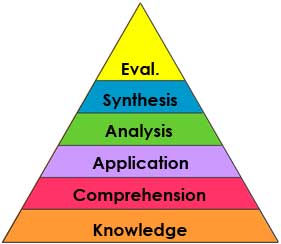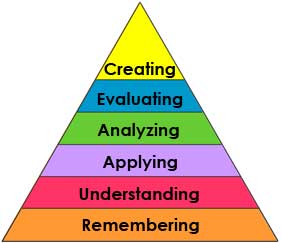Instructional Design Models, Theories & Methodology:
Bloom's Learning Taxonomy Summary (Original Model)
Benjamin Bloom developed a classification of levels of intellectual behavior important in the learning process in 1956. His model included nouns arranged from the simplest cognitive task at the bottom of the pyramid to the most complex at the top of the pyramid. Students start at the bottom of the pyramid and are able to move up after they have mastered each level. An illustration of the six levels is shown below (Overbaugh, 2011).
 The six levels included (Bjorn, 2004):
The six levels included (Bjorn, 2004):
- Knowledge- recalling specific information such as dates, events, and definitions
- Comprehension- interpreting, understanding, predicting, and summarizing information
- Application- using concepts to solve, demonstrate or classify new situations
- Analysis- organizing and identifying patterns or components to explain situations
- Synthesis- combining ideas or generalizing to predict or create new ideas
- Evaluation- compare, assess, or judge concepts
The Level's of Bloom According to The Pirates of the Carribean
Summary (New Model)
Later in the 1990’s, Lorin Anderson (a former student of Benjamin Bloom) along with “cognitive psychologists, curriculum theorists and instructional researches, and testing and assessment specialists” updated the taxonomy to reflect 21st century skills (Forehand, 2010). The biggest differences are that the new taxonomy is written as verbs rather than as nouns and some of the categories were renamed.
 The six levels now include:
The six levels now include:
- Remembering- recalling specific information such as dates, events, definitions, etc.
- Understanding- interpreting, understanding, predicting, and summarizing information
- Applying- using concepts to solve, demonstrate or classify new situations
- Analyzing- organizing and identifying patterns or components to explain situations
- Evaluating- compare, assess, or judge concepts
- Creating - combining ideas or generalizing to predict or create new ideas
Best Used By
Bloom’s Taxonomy can be used by any teacher or instructor. The revised version assists with planning instruction, especially from a bottom-up sequence where students learn all of the prerequisite knowledge first before moving on to more difficult tasks. To design instruction, you could write your learning objectives based on one of the six levels in Bloom’s Taxonomy and then asses the learners based on the verb chosen. Students are also capable of more complex tasks after the initial assessment.
Example for “Ball in Cup” Laboratory Activity:
- Learning Objective: The students will calculate the distance a projectile will travel given the time in flight and horizontal velocity. (Bloom’s Level 3, Applying)
- Prerequisite knowledge:
- Definition of a projectile (Level 1, Remembering)
- Understanding how projectiles travel (Level 2, Understanding)
- Prerequisite knowledge:
- Assessment: Have the students predict/calculate where an object will fall given the time in flight and horizontal velocity and then see if their predictions are correct in the laboratory.
 In the example above, the students would have learned the definition of a projectile and how projectiles travel before attempting this lab. The background knowledge, or the lower level of Bloom’s Taxonomy, is the prerequisite knowledge. After this activity, the students could move to more complex tasks such as:
In the example above, the students would have learned the definition of a projectile and how projectiles travel before attempting this lab. The background knowledge, or the lower level of Bloom’s Taxonomy, is the prerequisite knowledge. After this activity, the students could move to more complex tasks such as:
- Determine why their answer was wrong (Level 4, Analyzing),
- Determine a different way to solve for the horizontal position (Level 5, Evaluating)
- Create a lab report or design another experiment (Level 6, Creating)
Any type of teacher or instructor could use Bloom’s Taxonomy to help guide their instructional design. Below is an example that I created of the sequence that I use when coaching my freshmen setters. First they must know the basic definition and purpose. Next they show me that they can perform the task. After more practice and careful analysis, I expect them to run their own offense through plays that they have created by the end of the season.
Any teacher using technology in their classroom can use Bloom’s Taxonomy- It’s not specifically for material that builds on itself. Below is an image that describes different Web2.0 tools and how they fit into Bloom’s Taxonomy (Fisher, 2009).
Strengths/ Weaknesses
|
|
Similarities to Other Learning Models
There are other less-known taxonomies that are similar to Bloom’s. However, the connections that have been made between Boom’s Taxonomy and other learning models are more relevant. Bloom’s Taxonomy can be incorporated into any other learning-style or modality. Here is a “Planning Matrix” of Bloom’s Taxonomy linked with Gardner’s Multiple Intelligences (White, 2010). Bloom’s Taxonomy can also be seen in Cognitive Load Theory where learners are able to perform complex tasks by connecting information with existing schemas, where the prior knowledge would be the low levels of Bloom’s Taxonomy (Clark, Nguyen, & Sweller, 2006)
Further Reading/ Bloom's Taxonomy Resources
- Bloom's Digital Taxonomy
- Useful Table on Applying Bloom's Verbs
- Understanding and Using Bloom's Taxonomy to Improve Instructional Practice
- Wikipedia- Bloom's Taxonomy
- Bloom's Taxonomy Question Stems
- Bloom's Taxonomy Question & Task Design Wheel (based on the old version but still very useful!)
References
Bjorn, S. (2004). Bloom's Taxonomy. (U. o. Victoria, Producer) Retrieved July 22, 2011, from University of Victoria: http://www.coun.uvic.ca/learning/exams/blooms-taxonomy.html
Bloom's Taxonomy According to Pirates of the Caribbean . (2009, December 1). Retrieved July 23, 2011, from YouTube: http://www.youtube.com/watch?v=qjhKmhKjzsQ
Clark, R., Nguyen, F., & Sweller, J. (2006). Efficiency in Learning; Evidence-Based Guidelines to Manage Cognitive Load. San Francisco: Pfeiffer.
Fisher, M. (2009, February 27). DigiGogy. Retrieved July 24, 2011, from Blogspot.com: http://digigogy.blogspot.com/2009/02/digital-blooms-visual.html
Forehand, M. (2010, July 6). Bloom's Taxonomy - Emerging Perspectives on Learning, Teaching and Technology. Retrieved July 22, 2011, from http://www.roe11.k12.il.us/GES%20Stuff/Day%204/Process
/Blooms/Mary%20Forehand%20discussion-Bloom%27s%20Taxonomy.pdf
Marzano, R. J., & Kendall, J. S. (2007). The New Taxonomy of Educational Objectives. Thousand Oaks, California: Corwin Press.
Overbaugh, R. C. (2011, May 11). Bloom's Taxonomy. Retrieved July 19, 2011, from http://www.odu.edu/educ/roverbau/Bloom/blooms_taxonomy.htm
Star Wars and Blooms Taxonomy Revised. (2010, August 4). Retrieved July 23, 2011, from YouTube: http://www.youtube.com/watch?v=gG52jFCWiac
White, S. (2010, October 26). Bloom's Taxonomy, Thinking Strategies, & Multiple Intelligences – Planning Matrix. Retrieved August 2, 2011, from http://reapgatecluster.wikispaces.com/file/view/Bloom%
E2%80%99s+taxonomy,+thinking+strategies+and+multiple+intelligences+-+Planning+matrix.pdf
